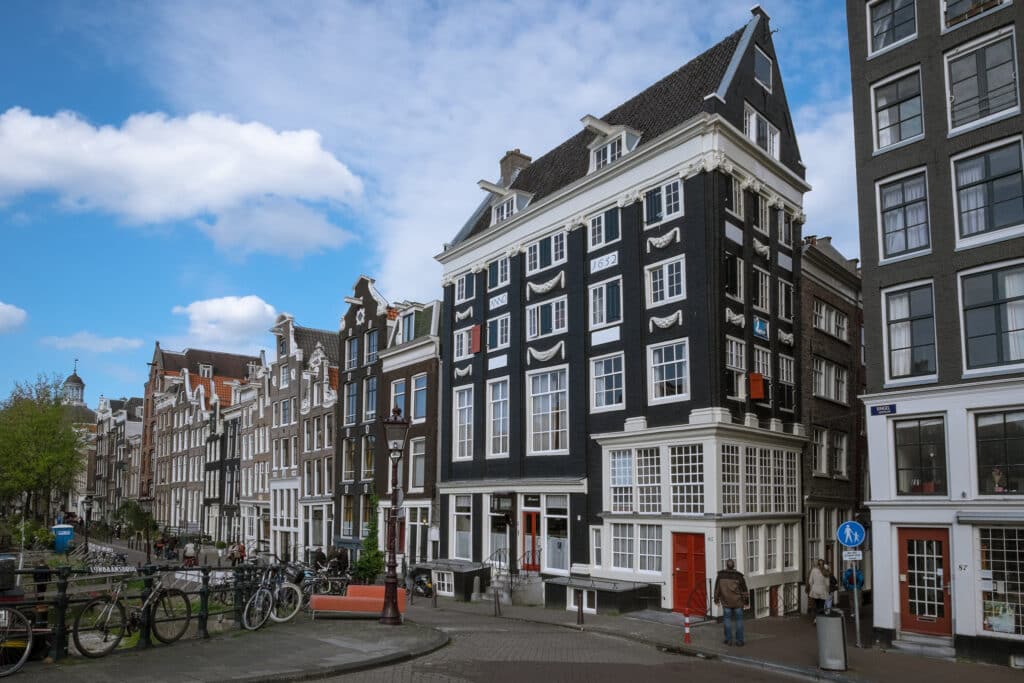Visit Amsterdam's leaning houses are an integral part of the landscape.
When you're there, you'll quickly notice that most of Amsterdam's tall, narrow houses have their own unique architecture.
Let's find out everything you need to know about these exceptional buildings.
House in Amsterdam: article summary
Why do Amsterdam houses have hooks?
First of all, why do Amsterdam buildings have hooks? Many of Amsterdam's leaning buildings have a cantilever beam and a hook protruding from the gable at roof level.
These would be used to transport goods and merchandise, in the case of warehouses, to higher levels.
The houses were built with a forward tilt to prevent objects from colliding with the building's facade. Now you know why there are leaning houses in Amsterdam and why they have hooks.

An advanced winch and pulley system
The pulleys evoke a part of the history of the buildings and the trades that were carried out there.
Gabled architecture has gradually evolved from simple "triangular" and "stepped" gables to more decorative "collar" and "bell" gables.
Why are Amsterdam houses so narrow?
Due to the instability of planning laws in the 15th century, building obligations were strict.
The plan called for the facades to be built as follows with lightweight materials and large windows to reduce weight.
Taxes were charged according to the width of the facade, which explains why most Amsterdam houses are slim and narrow.
During the 17th century, the town became more prosperous and with it wider, double-fronted merchant houses sprang up along Gentlemen's Canal and Golden Bend, with elaborate gables and stature.
Can you visit the houses of Amsterdam
There's one house you can visit during your stay in Amsterdam. This is the very famous Anne Frank House.
Anne Frank's former home attracts around a million visitors a year. For more than two years, Anne Frank and her family hid in the annex of a building on Prinsengracht. where Anne's father, Otto Frank, had his business.
Every time you pass the building, you'll notice that there are long queues outside to get tickets. To avoid any inconvenience, I advise you to book your ticket online.
This way, you can bypass the queues. Be careful, though: you need to book a few weeks in advance. The venue is often fully booked for several months, and it can be difficult to find a suitable time.
A museum that helps you understand many aspects of the city
The museum is a thought-provoking and thought-provoking experience, and the exhibits describe the difficulties endured by the family.
Unfortunately, they suffered in vain as Otto Frank was the only surviving member of the family to emerge from the concentration camps.
Pushing open the door disguised as a bookcase to climb the stairs to the attic is likely to be a particularly poignant experience.
You'll get a glimpse into the lives of the occupants as you walk through the building. You'll also be able to see how Amsterdam's inhabitants lived in these sometimes very narrow houses.
Amsterdam's houses have a distinctive style. During your visit, I advise you to stop in front of them. You'll be able to enjoy the atmosphere they bring to the city!
What to do in Amsterdam in 1 day, 2 days, 3 days, 5 days, a week?
Whatever the length of your stay, I invite you to download my special Amsterdam guide.
It's free and in PDF format.
All you have to do is tell me below which e-mail address you'd like to receive it at.
EDIT: you can't enter your email?
Take the quiz at the top of this article and you'll be able to register your email address to receive the special Amsterdam guide!
Leave a Reply